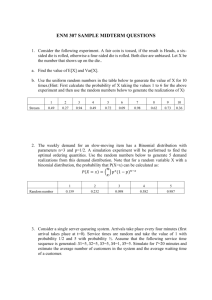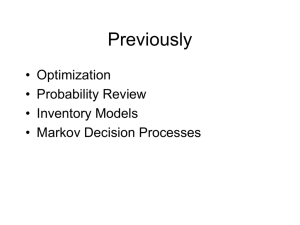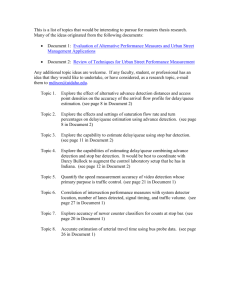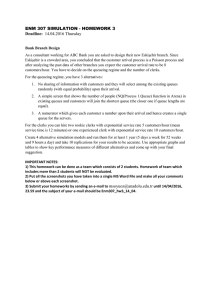Advanced Queueing Theory
advertisement
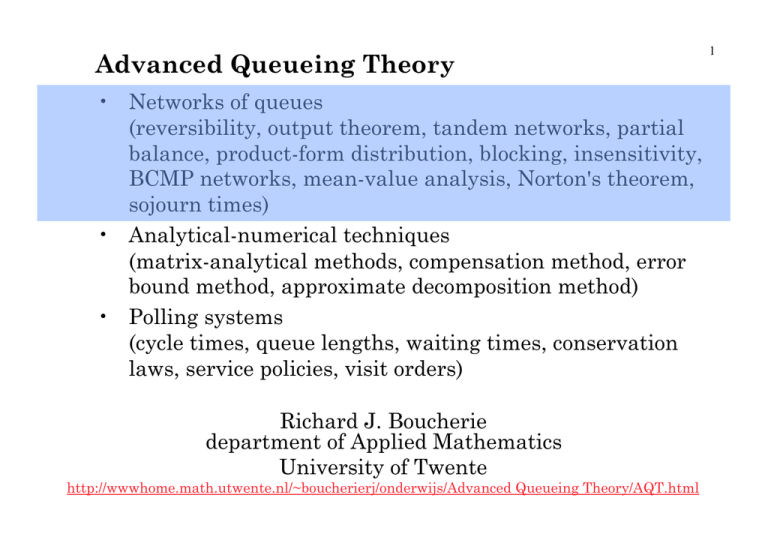
Advanced Queueing Theory
• Networks of queues
(reversibility, output theorem, tandem networks, partial
balance, product-form distribution, blocking, insensitivity,
BCMP networks, mean-value analysis, Norton's theorem,
sojourn times)
• Analytical-numerical techniques
(matrix-analytical methods, compensation method, error
bound method, approximate decomposition method)
• Polling systems
(cycle times, queue lengths, waiting times, conservation
laws, service policies, visit orders)
Richard J. Boucherie
department of Applied Mathematics
University of Twente
http://wwwhome.math.utwente.nl/~boucherierj/onderwijs/Advanced Queueing Theory/AQT.html
1
Last time on AQT …
•
•
•
•
•
•
Output reversible queue
Tandem network of queues
Jackson network
Kelly Whittle network
Partial balance
Blocking
2
Advanced Queueing Theory
3
Today (lecture 3): queue length based on Kelly’s
lemma
Nelson, sec 10.4—10.7, Kelly, chapter 3
• Kelly Whittle network
• Alternative proof
• Quasi reversibility
• Network of quasi reversible queues
• Queue disciplines, symmetric queues, BCMP networks
• PASTA
• Mean Value Analysis
Kelly Whittle network
Theorem: The equilibrium distribution for the Kelly Whittle
network is
where
and π satisfies partial balance
4
5
Insert equilibrium distribution and rates in partial balance
This is the beauty of partial balance!
rate in = rate out
Advanced Queueing Theory
6
Today (lecture 3): queue length based on Kelly’s
lemma
Nelson, sec 10.4—10.7, Kelly, chapter 3
• Kelly Whittle network
• Alternative proof
• Quasi reversibility
• Network of quasi reversible queues
• Queue disciplines, symmetric queues, BCMP networks
• PASTA
• Mean Value Analysis
Time reversed process
7
• Theorem: If X(t) is a stationary Markov process with transition
rates q(j,k), and equilibrium distribution π(j), j ∈ S, then the
reversed process X(τ - t) is a stationary Markov process with
transition rates
and the same equilibrium distribution.
€
€
• Theorem: Kelly’s lemma
Let X(t) be a stationary Markov process with transition rates
q(j,k). If we can find a collection of numbers q’(j,k) such that
q’(j)=q(j), j∈S, and a collection of positive numbers π (j), j ∈ S,
summing to unity, such that
€
then q’(j,k) are the transition rates of the time-reversed process,
and π (j), j∈S, is the equilibrium distribution
€ €of both processes.
8
Alternative proof: use Kelly’s lemma
Forward rates
Guess
backward rates
Check conditions
9
Alternative proof: use Kelly’s lemma
Guess for equilibrium distribution
insert
Advanced Queueing Theory
10
Today (lecture 3): queue length based on Kelly’s
lemma
Nelson, sec 10.4—10.7, Kelly, chapter 3
• Kelly Whittle network
• Alternative proof
• Quasi reversibility
• Network of quasi reversible queues
• Queue disciplines, symmetric queues, BCMP networks
• PASTA
• Mean Value Analysis
Quasi-reversibility
• Multi class queueing network, class c∈ C
• A queue is quasi-reversible if its state x(t) is a stationary
Markov process with the property that the state of the queue
at time t0, x(t0), is independent
of
€
(i) arrival times of class c customers subsequent to time t0
(ii) departure times of class c customers prior to time t0.
• Theorem
If a queue is QR then
(i) arrival times of class c customers form independent
Poisson processes
(ii) departure times of class c customers form independent
Poisson processes.
Quasi-reversibility
• S(c,x) set of states queue contains one more class c
customer than in state x
• Arrival rate class c customer
independent of state x
• Thus arrival rate independent of prior events, and has
constant rate Poisson proces
Quasi-reversibility
• Multi class queueing network, class c∈ C
• S(c,x) set of states in which queue contains one more
class c than in state x
• Arrival rate class c customer
independent of state x €
• Departure rate class c customer
independent of state x
• Characterise QR, combine
• Partial balance
Advanced Queueing Theory
14
Today (lecture 3): queue length based on Kelly’s
lemma
Nelson, sec 10.4—10.7, Kelly, chapter 3
• Kelly Whittle network
• Alternative proof
• Quasi reversibility
• Network of quasi reversible queues
• Queue disciplines, symmetric queues, BCMP networks
• PASTA
• Mean Value Analysis
15
Network of quasi reversible queues
•
•
•
•
•
•
•
Multiclass queueing network, type i=1,..,I
J queues
Customer type identifies route
Poisson arrival rate per type ν(i), i=1,…,I
Route r(i,1),r(i,2),…,r(i,S(i))
Type i at stage s in queue r(i,s)
S(c,x) set of states in which queue contains one more class c
than in state x
• State X(t)=(x1(t),…,xJ(t))
• Fixed number of visits; cannot use Markov routing
• 1, 2, or 3 visits to queue: use 3 types
Network of quasi reversible queues
• Construct network by multiplying rates for individual queues
• Transition rates
• Arrival of type i causes queue k=r(i,1) to change at
• Departure type i from queue j = r(i,S(i))
• Routing
• Internal
16
Network of Quasi-reversible queues
• Rates
• Theorem : For an open network of QR queues
(i) the states of individual queues are independent at fixed time
(ii) an arriving customer sees the equilibrium distribution
(ii’) the equibrium distribution for a queue is as it would be in
isolation with arrivals forming a Poisson process.
(iii) time-reversal: another open network of QR queues
(iv) system is QR, so departures form Poisson process
Network of Quasi-reversible queues
• Proof of part (i): Kelly’s lemma
• Rates
• Transition rates reversed process (guess)
Network of Quasi-reversible queues
• Proof of part (i): Kelly’s lemma
• For
• We have
• Satisfied due to
Advanced Queueing Theory
20
Today (lecture 3): queue length based on Kelly’s
lemma
Nelson, sec 10.4—10.7, Kelly, chapter 3
• Kelly Whittle network
• Alternative proof
• Quasi reversibility
• Network of quasi reversible queues
• Queue disciplines, symmetric queues, BCMP networks
• PASTA
• Mean Value Analysis
Queue disciplines
• Operation of the queue j:
(i) Each job requires exponential(1) amount of service.
(ii) Total service effort supplied at rate ϕj(nj)
(iii) Proportion γ j(k,nj) of this effort directed to job in
position k, k=1,…, nj ; when this job leaves, his service is
completed, jobs in positions k+1,…, nj move to positions k,…,
nj -1.
(iv) When a job arrives at queue j he moves into position k
with probability δj(k,nj + 1),
k=1,…, nj +1; jobs previously in positions k,…, nj move to
positions k+1,…, nj +1.
Queue disciplines
• Operation of the queue j:
(i) Each job requires exponential(1) amount of service.
(ii) Total service effort supplied at rate ϕj(nj)
(iii) Proportion γ j(k,nj) of this effort directed to job in position
k,
(iv) job arriving at queue j moves into position k with prob.
δj(k,nj + 1)
• In the form of network of quasi reversible queues
• Examples: BCMP network
FCFS
LCFS
PS
infinite server queue,
Symmetric queues
• Operation of the queue j:
(i) Each job requires exponential(1) amount of service.
(ii) Total service effort supplied at rate ϕj(nj)
(iii) Proportion γ j(k,nj) of this effort directed to job in position
k,
(iv) job arriving at queue j moves into position k with prob.
δj(k,nj + 1)
•
•
•
•
Examples: IS, LCFS, PS
Symmetric queue QR for general service requirement
Instantaneous attention
Symmetric queue is insensitive
Quasi-reversibility and partial balance
• QR: fairly general queues, service disciplines, Markov
routing, product form equilibrium distribution
factorizes over queues.
• PB: fairly general relation between service rate at
queues, state-dependent routing (blocking), product
form equilibrium distribution factorizes over service
and routing parts.
• Identical for single type queueing network with
Markov routing
•
•
•
•
QR partial balance
NOT partial balance QR (exercise)
NOT QR Reversibility (see Nelson, ex 10.14)
NOT Reversibility QR (see Nelson, ex 10.12)
Advanced Queueing Theory
25
Today (lecture 3): queue length based on Kelly’s
lemma
Nelson, sec 10.4—10.7, Kelly, chapter 3
• Kelly Whittle network
• Alternative proof
• Quasi reversibility
• Network of quasi reversible queues
• Queue disciplines, symmetric queues, BCMP networks
• PASTA
• Mean Value Analysis
Arrival theorem
• PASTA:
The distribution of the number of customers in the system seen by a
a customer arriving to a system according to a Poisson process (i.e.,
at an arrival epoch) equals the distribution of the number of
customers at an arbitrary epoch.
• Arrival theorem (open Jackson network):
In an open network in equilibrium, a customer arriving to queue j
observes the equilibrium distribution.
• Arrival theorem (closed Jackson network):
In a closed networkin equilibrium, a customer arriving to queue j
observes the equilibrium distribution of the network containing one
customer less.
27
PASTA: Poisson Arrivals See Time Averages •
fraction of time system in state n
• probability outside observer sees n customers at time t
•
probability that arriving customer sees n customers at time t
(just before arrival at time t there are n customers in the system)
• in general PASTA: Poisson Arrivals See Time Averages 28
• Let C(t,t+h) event customer arrives in (t,t+h)
• For Poisson arrivals q(n,n+1)=λ so that
• Alternative explanation; PASTA holds in general!
PASTA: Poisson Arrivals See Time Averages 29
• Transient
• In equilibrium
30
MUSTA: Moving Units See Time Averages •
Palm probabilities: Each type of transition nnʼ for Markov chain associated with subset H of SxS \diag(SxS)
•
Example:transition in which customer queue i queue j
H ij = {(m + ei ,m + e j ),m + ei ,m + e j ∈ S}
m
•
Transition in which customer leaves queue i
H out
= H ij
i
j
•
Transition in which customer enters queue j
H inj = H ij
i
31
MUSTA: Moving Units See Time Averages •
NH process counting the H-transitions •
Palm probability PH (C) of event C given that H occurs: PH
∑
(C) =
∑
(n,n' )∈C
(n,n' )∈ H
•
π (n)q(n,n')
π (n)q(n,n')
, C⊆H
Probability customer queue i queue j sees state m
Pij (m) = PH ij ((m + ei ,m + e j )) =
π (m + ei )q(m + ei ,m + e j )
∑
(n,n' )∈ H ij
•
π (n)q(n,n')
,
Probability customer arriving to queue j sees state m
P j (m) = PH in
j
π (m + e )q(m + e ,m + e )
∑
( (m + e ,m + e )) =
,
π (n)q(n,n')
∑ ∑
i
i
i
i
j
i
(n,n' )∈ H ij
i
j
Kelly Whittle network
Theorem: The equilibrium distribution for the Kelly Whittle
network is
where
and π satisfies partial balance
32
MUSTA :Kelly Whittle network
Theorem: The distribution seen by a customer
moving from queue i tot queue j is
Entering queue j is
where
33
MUSTA 34
Advanced Queueing Theory
35
Today (lecture 3): queue length based on Kelly’s
lemma
Nelson, sec 10.4—10.7, Kelly, chapter 3
• Kelly Whittle network
• Alternative proof
• Quasi reversibility
• Network of quasi reversible queues
• Queue disciplines, symmetric queues, BCMP networks
• PASTA
• Mean Value Analysis
Gesloten netwerken: MVA
Average queue length, average sojourn times?
λm(i) arrival intensity queue i,
Fm(i) expeceted sojourn time i,
Lm(i) expected queue length queue i, when m cust in system
Arrival theorem, FCFS
Little’s formula
Gesloten netwerken: MVA
λm(i) arrival intensity queue i,
Fm(i) expeceted sojourn time i,
Lm(i) expected queue length queue i, when m cust in system
N
N
π i = ∑ π j ⋅ rji
λm (i) = ∑ λm ( j) ⋅ rji
j=1
N
N
j=1
€
i=1
€
€
• thus
N
λm = m ⋅ ∑ π i ⋅ Fm (i)
i=1
∑π
i=1
λm (i) = λm ⋅ π i , λm = ∑ λm (i)
• Little
,
−1
i
=1
• Mean Value Analysis
evaluates λm(i), Fm(i) en Lm(i) for all m,i recursively
– Find solution π of traffic equations
– for m=1 : F1(i)=1/µi for all i
recursion
– let Fm(i) known for all i
– Determine number of cust served per time unit at queue i :
λm (i) = λm ⋅ π i = m ⋅
{∑
N
j=1
−1
}
π j ⋅ Fm ( j)
⋅ πi
– Determine average number of customers at queue i
using Little
Lm (i) = λm (i)⋅ Fm (i)
– Determine average sojourn time at queue i for system
€containing m+1 customers using arrival theorem
1+ Lm (i)
Fm +1 (i) =
µi
€
Exercises
Exercises from Kelly, Reversibility and stochastic networks: 1.5.2, 1.6.4, 2.2.4, 2.3.5, 2.4.1, 3.1.3, 3.1.4, 3.2.3
Exercise on blocking: Consider a Jackson network of J queues with transition rates
1.
Give the equilibrium distribution, and show that this distribution satisfies partial balance
2.
Show that a customer arriving to queue i observes the equilibrium distribution
3.
Now assume that the total number of customer in the network is restricted not to exceed N. Give the
equilibrium distribution, and the distribution of the state observed by a customer arriving to queue 1
4.
Now assume that each queue has a capacity restriction, say the number in queue i is restricted not to exceed Ni.
Consider the stop protocol, where the arrival process, and each non-blocked queue is stopped until a service
completion has occurred at the blocked queue. Give the state space, and show that the equilibrium distribution
has a product form and satisfies partial balance. Give the distribution of the state observed by a customer
arriving to (and entering) queue 1.
5.
Again assume the capacity restrictions of 4). Assume that a customer arriving to a queue that has reached its
capacity restriction, say queue j, jumps over the queue, and selects a new destination according to the routing
probilities from queue j. Give the equilibrium distribution.
6.
Can the product form result of 4) be obtained via Quasi reversibility? If so, provide the proof of the product form
result via quasi reversibility.
Exercise on insensitivity: Consider a BCMP network consisting of infinite server queues, and single server queues,
where the single server queues may be FCFS, LCFS or PS. Assume Markov routing.
1.
Formule the BCMP network as a network of quasi reversible queues.
2.
Give the equilibrium distribution.
3.
Show that this distribution satisfies partial balance.
4.
Restrict the network to contain IS, LCFS, and PS queues only (symmetric queues). Prove that the equilibrium
is insensitive to the distibution of the service time at each of these queues using first the phase type
distribution approach, and then the formulation of Whittle.
5.
Indicate why the distribution cannot be insensitive to the service time distribution in an FCFS queue.
